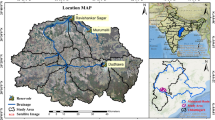Abstract
Water resources planning and management requires hydrologic models to estimate runoff from a catchment. For catchments with limited data, the choice of model and identification of its parameters is very important for development of a direct runoff hydrograph. A method is presented to determine a unique pair of hydrologic parameters of the Nash Model, number of linear cascade (n) and storage coefficient (k), using optimization based on Downhill Simplex technique. In this study physical parameters of the catchment are derived from (SPOT) satellite imageries of the basin using ERDAS software. Four different objective functions of varying complexity are tested to find the best solution. Weighted root mean square error (RMSE) and Model Efficiency (Nash-Sutcliffe coefficient) are used to evaluate the model performance. Using the NASH model, a direct surface runoff hydrograph (DSRH) is developed. Kaha catchment is part of Indus river system and is located in the semi-arid region of Pakistan. This catchment is dominated by hill torrent flows and is used in this work to demonstrate the applicability of the proposed method. Ten randomly selected rainfall-runoff events are used for calibration and five events are used for validation. Model results during validation are very promising with model efficiency exceeding 93% and error in peak discharge under 8%. The sensitivity of the Nash model output in response to variation in hydrologic parameters n and k is also investigated. When evaluating the hydrologic response of large catchments, model output is more sensitive to n as compared to k indicating that the runoff diffusion phenomenon is dominant compared to translation flow effects.
Similar content being viewed by others
References
Ahmad M, Ghumman R, Ahmad S (2009) Estimation of Clark’s instantaneous unit hydrograph parameters and development of direct surface runoff hydrograph. Water Resour Manage 23:2417–2435. doi:10.1007/s11269-008-9388-8
Al-Wagdany AS, Rao AR (1997) Estimation of the velocity parameter of the geomorphologic instantaneous unit hydrograph. Water Resour Manage 11:1–16
Bardossy A (2007) Calibration of hydrologic model parameters for ungauged catchments. J Hydrol Earth Syst Sci 11:703–710
Blueman AG (2003) Elementary statistics: a brief version. McGraw Hill, New York, pp 476–512
Dong SH (2007) Genetic algorithm based parameter estimation of Nash Model. J Water Resour Manage. doi:10.1007/s11269-007-9208-6
Gill PE, Murray W, Wright MH (1981) Practical optimization. Academic, London
Hanson G, Hashmi MA, VBB VIAK Sweden (1995) Conservation and development of land and water resources of upper Kaha hill torrent catchment. NESPAK, Lahore
James LD, Burges SJ (1982) Selection, calibration and testing of hydrologic models: hydrologic modeling of small watersheds. In: Hann CT, Johnson HP, Brakensiek DL (eds) ASAE monograph. St. Joseph, Michigan, pp 437–472
Katli L, Indrajeet C (2005) Sensitivity analysis, calibration and validation for a multisite and multivariable SWAT model. J Am Water Resour Assoc 41(5):1077–1089
Lee MT, Blank D, Delleur JW (1972) A program for estimating runoff from Indiana watershed. Part II. Assembly of hydrologic and geomorphologic data for small watersheds in Indiana, Tech. rep. N0. 23, Purdue Univ. Wat. Res. Res. Center, Lafayette
Linsley RK, Kohler MA, Paulhus JLH (1982) Hydrology for engineers. McGraw-Hill, New York
Michel CB (1998) Unit hydrographs derived from the Nash model. J Am Water Resour Assoc 34(1):167–177
Nash JE (1958) The form of instantaneous unit hydrograph. Int Assoc Sci Hydrol 51:546–557
Nash JE, Sutcliffe JV (1970) River flow forecasting through conceptual models. Part-I: a discussion of principles. J Hydrol 10(3):282–290
Patil S, Bardossy A (2006) Regionalization of runoff coefficient and parameters of an event based Nash-cascade model for predictions in ungauged basins. Geophys Res Abstr 8:74
Rosso R (1984) Nash model relation to Horton order ratios. Water Resour Res 20(7):914–920
Sahoo B, Chandarnath C, Narendra SR, Rajendra S, Rakesh K (2006) Flood estimation by GIUH based Clark and Nash models. J Hydrol Eng 11(6):515–525
Serrano SE (1997) Hydrology for engineers, geologists and envirornmental professionals. HydroScience, Lexington, pp 263–268
Singh PK, Bhunya PK, Mishra SK, Chaube UC (2007) An extended hybrid model for synthetic unit hydrograph derivation. J Hydrol 336:347–360
USACE (1986) Program description and user mannual for SSARR Model. USACE, Portland
USACE, Hydrologic Engineering Centre (HEC) (2000) HEC-HMS user’s manual. Davis, California. Available at http://www.hec.usace.army.mil/software/hec-hms/documentation/CPD-74B_2000Mar.pdf
Zelazinski J (1986) Application of the geomorphological instantaneous unit hydrograph theory to development of forecasting models in Poland. Hydrol Sci 31(2):263–270
Author information
Authors and Affiliations
Corresponding author
Rights and permissions
About this article
Cite this article
Ahmad, M.M., Ghumman, A.R., Ahmad, S. et al. Estimation of a Unique Pair of Nash Model Parameters: An Optimization Approach. Water Resour Manage 24, 2971–2989 (2010). https://doi.org/10.1007/s11269-010-9590-3
Received:
Accepted:
Published:
Issue Date:
DOI: https://doi.org/10.1007/s11269-010-9590-3




